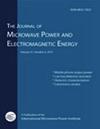微波和热超声真空浓缩法对芙蓉提取物质量参数的影响及浓度数学建模
IF 1.5
4区 工程技术
Q4 ENGINEERING, CHEMICAL
Journal of Microwave Power and Electromagnetic Energy
Pub Date : 2023-07-03
DOI:10.1080/08327823.2023.2235549
引用次数: 0
摘要
摘要本研究探讨了木槿提取物的浓度模型,以及浓缩过程对木槿提取物某些品质特性的影响。所有浓缩过程的绝对压力均为250mbar。在75°C和80°C下采用热真空浓缩工艺,在75°C和0.02 W/mL AED下采用热超声真空浓缩工艺,在180和300 W下采用微波真空浓缩处理。300w微波真空浓缩工艺处理时间最短。在13个模型中,Midilli是描述浓度数据最成功的模型(r2≥0.9951,χ2≤1.0185,RMSE≤1.0092)。浓缩样品的物理化学性质没有明显变化。然而,浓缩木槿样品的浊度值明显增加,而浓缩样品的花青素含量、组成和抗氧化活性值与初始样品相比显著降低。本文章由计算机程序翻译,如有差异,请以英文原文为准。
Effect of the microwave and thermosonic vacuum concentration methods on quality parameters of hibiscus (hibiscus sabdariffa L.) extract and mathematical modeling of concentration
Abstract This study investigates the modeling of the concentration of hibiscus extracts and the effect of the concentration process on some quality properties of hibiscus extracts. Absolute pressure was applied as 250 mbar in all concentration processes. Thermal vacuum concentration process was applied at 75 °C and 80 °C, thermosonic vacuum concentration process was applied at 75 °C and 0.02 W/mL AED, and microwave vacuum concentration treatment was applied at 180 and 300 W. The shortest processing time was achieved with the microwave vacuum concentration process at 300 W. Among the 13 models used, Midilli was the most successful model (R 2 ≥ 0.9951, χ2 ≤ 1.0185 and RMSE ≤ 1.0092)) in describing the concentration data. No significant change was determined in the physicochemical properties of the concentrated samples. However, a significant increase was determined in the turbidity values of the concentrated hibiscus samples, while a significant decrease was noted in the anthocyanin content and composition and antioxidant activity values of the concentrated samples compared to the initial sample.
求助全文
通过发布文献求助,成功后即可免费获取论文全文。
去求助
来源期刊

Journal of Microwave Power and Electromagnetic Energy
ENGINEERING, CHEMICAL-ENGINEERING, ELECTRICAL & ELECTRONIC
CiteScore
2.50
自引率
6.70%
发文量
21
期刊介绍:
The Journal of the Microwave Power Energy (JMPEE) is a quarterly publication of the International Microwave Power Institute (IMPI), aimed to be one of the primary sources of the most reliable information in the arts and sciences of microwave and RF technology. JMPEE provides space to engineers and researchers for presenting papers about non-communication applications of microwave and RF, mostly industrial, scientific, medical and instrumentation. Topics include, but are not limited to: applications in materials science and nanotechnology, characterization of biological tissues, food industry applications, green chemistry, health and therapeutic applications, microwave chemistry, microwave processing of materials, soil remediation, and waste processing.
 求助内容:
求助内容: 应助结果提醒方式:
应助结果提醒方式:


